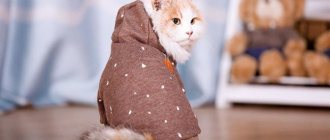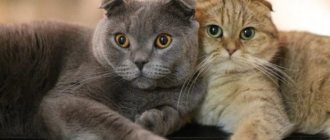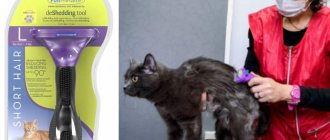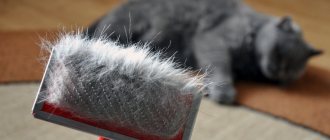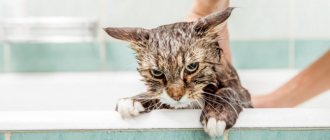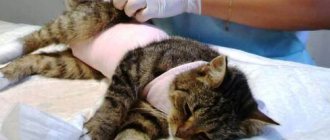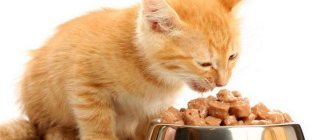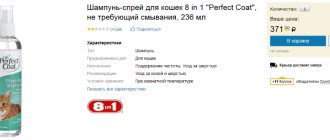care ALL ARTICLES 58897
There are different types of combs. So different that the uninitiated cat owner's eyes run wild - what to choose? And you need to choose what suits your cat. The whole difference is in the length of the coat and the presence/absence of undercoat. In addition, there are universal combs and combs for specific body parts.
Slicker, aka slicker:
The most cruel tool for cats. Remember: the bent teeth of a slicker have a strictly limited use: to lift the fur on the collar, pants and tail. You can’t use it constantly, as it tears out the undercoat, but does not comb through the fur, much less tangles. Not suitable for short-haired dogs - sharp teeth injure the skin. If possible, choose a slicker brush with blunt or ball-protected teeth.
Furminator for cats
The Furminator is a comb-trimmer for combing the undercoat of cats. This device was invented in America. Outwardly, it looks like a small rake. The nozzle is attached to a comfortable handle, and instead of teeth there are small blades on the device. This device is especially effective for caring for cats with long hair, since regular and high-quality removal of dead hair prevents the formation of tangles.
A furminator is needed to comb out the undercoat
The furminator works as follows:
- small teeth capture loose fibers of the undercoat;
- When the comb with blades moves, all captured hairs are pulled out.
Such devices are available in several versions. They differ in blade length and frequency of teeth: mini, medium and maxi. The modification is chosen based on the size of the animal and the length of its fur. For cats of short-haired breeds, a furminator with short blades is needed, for fluffier pets - with long blades. It is recommended to use the device 2-3 times a month. Usually after the first use the result becomes obvious.
The Furminator is used in the same way as a comb.
To properly comb your pet with this device, you need to remember a few rules:
- The animal needs to be calmed down.
- It is necessary to comb from withers to tail, but not vice versa.
- There is no need to press hard on the furminator (otherwise it will hurt the cat).
- If the wool becomes electrified, you can use an antistatic agent.
- Before combing, you need to examine your pet’s skin for rashes or wounds (if there are any, you need to postpone the procedure).
- If the wool has formed into tight tangles, you should carefully remove them with scissors or a tangle cutter.
- It is not recommended to start combing wet animal fur.
- The work must be done slowly, without using unnecessary force or sudden movements.
- Particular attention should be paid to treating areas in the genital area, tummy and paws of the pet.
- Cats of long-haired breeds should be combed starting from the lower layers (the outer hair is lifted with clips).
As a rule, the device comes with a replaceable nozzle (or several). A replacement blade can come in handy if one of the teeth suddenly becomes bent. If used correctly, the furminator will last 10–15 years.
Other items for brushing cats
Previously, regular (human) combs were used to brush cats. Some donated old combs for the benefit of the pet, while others purchased a separate comb for the animal.
If you do not want or cannot visit a grooming salon, then you can purchase all the necessary tools for combing your cat at home
Currently, in addition to the furminator, you can easily find and buy special combs (combs) for caring for animals:
- brushes included with cat doors;
- combs;
- combs;
- puffers;
- combined combs;
- trimmers, etc.
The laziest device is a cat door brush. This brush is used to frame the edges of the cat hole or door. When passing through the door, the cat grooms itself. The soft yet resilient bristles will do all the work for you. In addition, in these cases, the cat will not break out and scratch, because it is not forcibly dragged through the door. However, this method of scratching is more suitable for short-haired cats that do not need to be brushed frequently. For the same purpose, you can purchase a special arch for your pet.
You can easily make an arch with a brush yourself
Brushes are also manual. Such a tool can be used for the main procedure. If you can use a furminator every other day or two, then you can use a brush at least every day. This is especially appropriate if your cat loves massage. There are several types of such combs:
- with plastic teeth;
- with metal teeth;
- with bristles;
- combined.
The principle of choosing a brush is still the same. A comb with long teeth (bristles) is for long-haired cats, and a comb with short teeth is for short-haired cats. The main requirement when purchasing such a tool: check its quality. The handle should be comfortable, the tips of the teeth should have a “drop”, and the bristles should “sit” tightly in the pillow. If tufts of bristles fall out of the comb, it will quickly become unusable.
Once upon a time I had an uncomfortable brush-comb (many people had these). The base of this thing was in the form of a fish skeleton. They all were brown, but mine was bright green, neon (an unusual color for those years). But it was terribly uncomfortable, and hair got stuck in the fish ribs. A year later, I gave up this comb and donated it to Musa (my grandmother’s cat). Musya loved to be laid on her lap and combed for several hours. However, it soon became clear that even the cat did not like the beautiful green brush. It turned out that the instrument was defective. On these very “ribs” there were burrs that clung to the hair.
Photo gallery: different types of brushes
The brush in the form of an attachment for the hand also functions as a massager.
Combined brushes are the most practical
Combs with bristles are the most comfortable for cats
For cats with long hair, a comb is more suitable. This is a comb with one row of long teeth. Combs can be wooden, plastic or metal. Wooden combs do not harm the hair, but quickly become unusable (crack, break). Plastic and metal ones last a very long time, but can electrify the hair. Therefore, you need to remember about the antistatic agent. The combs are ideal for regular brushing. With their help, you can comb out unnecessary undercoat and tidy up the guard hairs. You can choose this comb with or without a handle.
Fine-tooth combs can help identify fleas on your pet. To do this, you need to run along the cat's fur from the ear to the shoulder blade (pressing a little). The teeth should touch the skin (so the fleas can't hide), but it shouldn't hurt the cat. If the comb is plastic, then it is better to purchase a comb in any color except black and white.
If you have several cats, do not buy them combs of the same color.
To care for the hair of the fluffiest pets, you need a slicker. This is a brush-like comb with thin but curved metal teeth. This tool is especially effective during shedding season, as it easily captures and combs out most of the lost hair.
There are cats whose fur is short and the undercoat is very thick. These cats include representatives of the British Shorthair breed. The British also need to be combed with a slicker brush. Only they need to select a tool with short teeth. Ideally, these teeth are also straight.
Some slicker teeth have a “droplet” on them. This is a thickening at the end of the clove, necessary to protect the animal’s skin from mechanical damage. But not every cat breeder can afford the luxury of feeling sorry for their cat. Most professional groomers believe that drop slickers are not suitable for cats with very long hair (and a lot of undercoat). These cats include Persian or Angora. The fact is that a droplet can interfere with the guard hairs, tangling them even more. This can cause long hairs to fall out prematurely. It is recommended to use a gentle tool for kitten hygiene.
Photo gallery: different types of powder puffers
Puffers for kittens come in bright colors
Combination comb - a convenient budget option
Short-toothed slickers are suitable for grooming short-haired cats.
Long-toothed brushes are suitable for hygiene of Persian and Angora cats
To make brushing your cat successful and painless, you need to follow some recommendations:
- You should only comb your cat in the direction of hair growth.
- To avoid damaging healthy guard hairs, combing should be done slowly.
- It is better to start the procedure from the neck and back, moving to the chest and sides (last of all - the “pants” and ponytail).
During the molting period, the slicker is used 2-3 times a week, and the rest of the time, once a week is enough. There are also many other tools and devices.
One of my friends has an old white cat. He is mongrel, with short and dull hair. The cat is very affectionate, constantly purrs and caresses, but sheds a lot. His owner bought massage attachments (that fit on the hand) with silicone teeth and nailed them to the doorposts at a height of about 20–25 centimeters from the floor. At first I decided that this would help with the “knocking” of doors. It turned out that the cat rubs against these pads, leaving fallen fur on them.
Colt cutters:
For different lengths of wool, there are different lengths of teeth-blades. Using a mat cutter, you need to comb the wool in the place of the mat, pointing the blades down.
grooming
Comments ()
Log in to leave a comment
How to choose a cat combing tool
If you decide to buy a furminator, then you need to make a choice based on several factors:
- wool length (tooth length);
- size of the animal (coverage area);
- the material from which the handle is made (plastic or rubberized);
- tool design;
- the presence of a FURejector button for removing hair from the blade (only on Deluxe Furminators, i.e. the highest quality).
When choosing a brush, you need to take into account your pet’s preferences.
If everything is clear with the length of the blades, then questions may remain related to the coverage area. This refers to the size of the animal, because the width of the furminator comb itself depends on this. In addition, there are also arc-shaped nozzles. There are several sizes of furminator:
- X-Small (for small animals and kittens, comb width - 3.2 cm);
- Small (for medium cats up to 6 kg, comb width - from 3.3 cm to 4.5 cm);
- Medium (for large animals from 6 kg to 20 kg, comb width - from 4.5 cm to 7 cm);
- Large (for large cats, comb width - 10 cm);
- X-Large (comb width - 12–13, not applicable for cats).
Original furminators are also divided into 2 classes: deluxe and classic. The only difference is the presence of the FURejector button on the first one.
On one side of the Furminator Deluxe there is a comb, and on the other there is a gray button for removing hair from the blades
Combs, brushes and other combs are chosen according to the same principle: quality, price and design. There are several subtleties that will help you make the right choice:
- The most expensive comb does not have to be the best.
- If you choose a brush, apply it to your cheek (the teeth should not prick).
- If you are going to buy a brush/mitten/attachment with rubber teeth, try running it discreetly through your hair (they should not “cling” to the rubber).
- You can ask the seller for a certificate of conformity (such a document must be attached to a branded product).
- Inspect the comb visually (there should be no burrs or cracks on it, the teeth should not be bent, if there are drops, they should be on each tooth).
- When purchasing a comb, inspect the row of teeth in the light (the gap between the teeth should be absolutely clean, they should be strictly parallel to each other).
When I choose a device whose structure is not completely clear to me, I carefully study the packaging. Sellers don't like it very much, but I try to scrutinize all the fine print. It is important for me that the packaging indicates the contact phone number and website of the distributor - a person or organization engaged in large purchases of goods from the manufacturer for the purpose of further sale (what if a defect is discovered and I have to return the goods). Also, if I buy an expensive device, I check with the seller about the possibility of an exchange or return. Most merchants say that once the package is opened, returns are not possible.
Video: how to choose a comb for a cat
Which cats and kittens need a comb?
It will not be a revelation to anyone that long-haired breeds require more care from humans than short-haired or completely hairless representatives of the cat family. There is no point in combing your cat anyhow - in any case, the choice should be thoughtful and conscious.
Indications
Ignoring the combing process will not work. First, brushing your cat's hair will make your home cleaner. Secondly, it prevents the animal from clogging the gastrointestinal tract and vomiting with hair.
Thirdly, it is important for the health of the tailed animal. If you do not take care of its fur, it will begin to get tangled in tangles, and later these tangles will turn into a hard shell. Murka will not be able to wash himself or scratch himself. But under the shell the skin will swell, which will provoke the development of bacteria. You will have to get rid of this already at the table of a veterinarian or groomer.
When not to use a cat scratcher
Even such a necessary procedure as combing cats can be hazardous to health or simply undesirable for some of them.
First of all, do not use a furminator if the animal does not have an undercoat or a fur coat with some peculiarities. Here is a list of breeds for which brushing is contraindicated:
- oriental;
- Turkish Angora;
- Cornish Rex;
- Devon Rex;
- Burmese and Singaporean.
Do not use the brush on the animal immediately after bathing. You need to wait until it dries completely and only then start caring for it.
Also, do not use cheap and low-quality combs with sharp metal teeth that do not have any protection at the ends. This is harmful not only to the fur, but also to the pet’s skin.
And if the four-legged dog has scratches, abrasions, ulcers and wounds, then scratching should be delayed until the skin damage goes away.
Have you abandoned your pet or picked up an animal from the street with huge mats? Under no circumstances try to comb them yourself! This way you can hurt your pet and only ruin everything. It’s better to contact a veterinarian, groomer, or buy tangle cutters - and rid the purr of tangles yourself.
What is important to pay attention to when purchasing
To avoid the cat’s reflex to the sound of a comb, it is important to pay attention to some nuances when purchasing a device. These include:
- the thicker a pet’s fur is, the more frequent the teeth should be (it doesn’t matter what type of tool it is – a brush, comb, comb or slicker);
- For short wool, short teeth are used, and for long wool, large ones;
- the steel used to make the comb must be of high quality and not oxidize when in contact with moisture;
- To prevent the wool from becoming electrified, it is recommended to choose only natural brushes made from high-quality materials.
Looking at the photos of combing devices, you can choose the right tool for caring for your pet.
How to comb a cat: types of accessories
Manufacturers offer a huge variety of products designed for combing cats. You will be able to decide for yourself what is the best way to groom your cat and what function each tool performs once you get to know them all.
Combs and combs
Combs and combs provide gentle and superficial care. The owner chooses the frequency of the teeth according to his taste, depending on the thickness of the cover. If it is very fluffy and long, then combs and combs with sparse links are suitable, and if the coat is short - with frequent and small ones.
Slickers (slickers)
They are equipped with metal teeth and have the appearance of a brush. Some owners purchase a slicker brush to untangle tangles, but this should not be done.
Furminators
The Furminator is a rake with fine teeth. There are two types of furminators: classic and deluxe. They differ in the width of the ridge and appearance. There are devices with both short and long teeth.
It is forbidden to comb a cat's fur with a furminator if it has skin diseases or wounds.
Mittens and gloves
At one time, such gloves and mittens were a real must-have among animal owners. It's all about the convenient form in the form of a mitten and efficiency. Many owners noticed that with a mitten they were able to collect more hairs than with other devices.
Mittens and gloves are made of silicone or soft rubber, that is, the pet does not experience discomfort at all, on the contrary, it receives a pleasant massage session.
Combs with blade or spinning teeth
The blades allow you to thin out the fur a little so that it is not so tangled. Typically, groomers use such devices. And the miracle comb with rotating teeth looks like a regular flat comb, but the teeth in it are not fixed in the body - they rotate, which allows you to remove much more dead hair than with a regular comb. Excellent for four-legged animals with a fluffy undercoat.
Colt cutters
In pet stores you can find three types of tangle cutters: vertical, horizontal and drop-shaped. From a distance, the tangle cutter looks like a comb, but if you look closely, you can see the double-edged protrusions. Thus, when combing your pet with a mat cutter, you cut off hairs.
But you need to work with this thing extremely carefully and first “teach your hand.” Otherwise, it is better to take the animal to a veterinary clinic or grooming salon, where a professional can deal with the mats.
Anti-flea combs
This comb has rounded tips of the teeth, so its use will not cause any harm to the “patient”. The teeth themselves are extremely frequent. The comb helps to get rid of not only excess hair, but also parasites.
Criteria for choosing a comb
You won’t be able to buy the first or cheapest brush you come across – in most cases it will be a waste of money. It is important to approach the issue of choice responsibly, taking into account several factors.
Animal fur length
When purchasing a device, consider the length of your tailed companion's fur. A comb for short-haired cats should have short and frequent teeth. Long-haired breeds will benefit from fine teeth and multi-level brushes.
Wool quality
Consider the quality of your pet’s coat: does it have an undercoat, does it often form tangled areas, etc.
Accessory material
Stick with brushes with metal teeth or natural bristles. The body material must be made of wood or steel. Before buying, smell the device - if it emits a strong, unpleasant odor, this is a sign of a low-quality product. In addition, the fluffy is unlikely to agree to be combed with something that smells of “chemicals” or something else. Ideally, the handle will be rubberized - this way you will avoid slipping.
Size of the device and its teeth (as well as their frequency)
Choose a device that fits perfectly in your hand, and you will not experience any discomfort when working with it. Consider your pet's size. If he is still small, do not use a large comb for an adult cat.
The frequency of the teeth depends on the length of the coat. The longer it is, the further the distance between the teeth should be.

